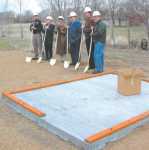County breaks ground on new jail facility

The Elmore County Commissioners and Sheriff Rick Layher put their shovels in the ground Monday and turned a spade of earth to mark the beginning of the construction phase for the new county jail.
A $7.5 million bond was approved by the voters last May to construct a greatly expanded state-of-the-art jail facility for the county. It was the fourth time the issue had come before the voters. After having failed the previous three times voters gave their approval the fourth time by an 80 percent margin.
In brief groundbreaking ceremonies Monday afternoon at the site just below the police station, Commissioner Larry Rose noted it took a long time for the taxpayers to see the need for the jail, but he thanked them for their support at the last bond election. "We had some other opportunities" to build a jail he noted, alluding to the possibility of using certificates of participation that the county had considered at one time, "but we didn't want to do it without the taxpayers' support. I want to thank them."
Sheriff Rick Layher thanked the scores of county officials and employees, as well as the citizens who served on the various advisory and publicity groups, for their efforts in making the project come to fruition, noting, "this will be a great facility."
The target date for completion of the project is March 1, 2007.
At the time of last years' bond election, Elmore County's current jail was rated as the worst in Idaho, failing to meet a large number of current standards.
The first effort to build a new jail, a $4.5 million proposal in 1994, would have included, in addition to the jail and dispatch center, administrative offices for the sheriff and police departments. But as costs rose over the years, the design was considerably scaled back.
The police department eventually built its own administrative building, and under the current plan, administrative offices and the driver's license bureau for the sheriff's department will remain at the current Law Enforcement Building.
The current jail can handle a maximum, under the best circumstances of only 23 inmates. The new facility will be able to house up to 136 inmates, and is designed for easy expansion in the future.
The new facilitywill be a 28,500-square-foot jail that Layher believes will provide all the capacity the growing county will need for the next 20 years.
Until it's filled by local prisoners, the sheriff hopes to earn some revenue by charging other counties to hold their excess prisoners, rather than spending the $45 a day he currently has to spend sending his excess prisoners to other jails (primarily Owyhee County).
While the present jail is deficient in most of the major standards set by the state and federal government, the new jail will meet or exceed all current standards.
From a central control area, jailers will be able to see into all seven major cell-block areas of proposed facility. That isn't possible in the current jail.
One area will provide eight beds designed for prisoners requiring medical isolation.
Two 14-bed bays (one each for male and female prisoners), will be designed for maximum security prisoners where each inmate could be locked down in isolation if necessary.
Four 16-bed bays will serve the "general" population of prisoners.
Since the control room itself is a secure facility, security is doubly assured, Layher noted.
The new jail will include two specially designed and secure exercise areas, one indoors and one outdoors, that would meet all current standards. The existing jail uses a chain-link fenced-in area known as the "dog run" for outside exercise, and the jail's garage-like sally port for inside exercise.
The new jail also will have three 12-bed bays for minimum-security work-release prisoners. "Work release prisoners have to be kept separate from the general population," Layher said, "and since they're minimum security, it's not as expensive." Currently, work-release prisoners are held in a room in the basement of the current jail, an area that has serious security issues.
In addition, the new jail will have a sally port to unload prisoners from vehicles, a secure booking area, and a kitchen and laundry area. Except for supervisors and a nutritionist (cook) on duty, most of the work there will be done by trustees.
The new jail also will feature a new dispatch center, with full enhanced 911 capabilities.
Finally, the new jail will include a lobby and visitation area (complete with special rooms for lawyers to talk to their clients), and a video arraignment area. That would allow officers to have prisoners arraigned by "teleconference" with judges, greatly reducing the need to transport prisoners to the courthouse, and thereby increasing community security. "That'll save us a lot of money," Layher said.
Most importantly, Layher said, the new jail will provide "humane" treatment for all prisoners, something the current jail is having trouble achieving.
The bond will be paid off in 15 years.
